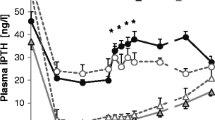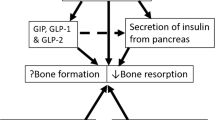Abstract.
We have previously demonstrated that parathyroid hormone (PTH) infusion decreases glucose disappearance rate (Kg) in vivo. Because in the rodent model used it was not possible to determine whether the PTH itself, the induced hypercalcemia, or both contributed to the glucose intolerance, we examined the effect of vitamin D infusion on insulin-mediated glucose disposal. In this model also hypercalcemia is induced but PTH levels are suppressed. Thirty male Sprague Dawley rats were continuously infused with vit D for 5 days using an Alzet miniosmotic pump, at a rate of 9.7 pmol/hour. Thirty controls were infused with the vehicle alone. On the 5th day, glucose 700 mg/kg and insulin 0.35 U/kg were given as a bolus through the left femoral vein and blood samples were obtained from the right femoral vein just prior to and at 2, 5, 10, and 20 minutes post-glucose/insulin infusion. At the end of 5 days, plasma calcium levels were higher in the vit D-infused rats than in the control rats (12.8 ± 0.1 versus 10.0 ± 0.1 mg/dL, P < 0.01) and rat PTH levels were suppressed (2.1 ± 0.1 versus 62 ± 12 pg/ml, P < 0.01). Glucose levels were higher in the vit D animals only at 5 minutes following glucose/insulin bolus (375 ± 7 versus 350 ± 6 mg/dL, P < 0.01) but at no other time. There were no differences between serum insulin levels at any time. Unlike previous findings in PTH-infused rats, Kg (measured from 2 to 20 minutes following glucose/insulin bolus) was not different between groups (4.5 ± 0.3 versus 4.7 ± 0.2, P= 0.92.) A positive correlation between serum calcium and serum glucose was found only at 5 minutes (r = 0.55, P < 0.01) and only in the vit D animals. The areas under the glucose curves approached statistically significant differences (vit D-infused 5258 ± 142 mg/dL/18 minutes versus control 4947 ± 127, P= 0.06.) Analysis of serum glucose data by two-factor analysis of variance (ANOVA) suggests that the two groups differ slightly in glucose values (P= 0.03) but have parallel Kg. In order to define whether different effects of PTH (1–34) and vit D on intracellular calcium [Ca2+]i levels could partly explain the different effects of PTH and vit D infusion on glucose disposal, we investigated the effect of PTH and vit D infusions on basal and concanavalin A (con A)-stimulated changes in mononuclear [Ca+2]i levels. Following 5 days of PTH, vit D, or control infusion, peripheral mononuclear cells were incubated with 50 μg/ml con A. Changes in [Ca+2]i over 5 minutes were calculated by flow cytometric measurement of the calcium sensitive fluo-3 AM dye. Despite achieving significant and comparable degrees of hypercalcemia in the PTH and vit D infused animals, there were no differences in basal or con A-stimulated [Ca+2]i levels from control. Consequently, we conclude that vit D-induced hypercalcemia associated with suppressed PTH levels has mild affects on glucose homeostasis but does not affect glucose disappearance rate in vivo (Kg) as does hypercalcemia induced by PTH infusion, and that neither chronic PTH infusion nor chronic vit D infusion are associated with long-standing changes in [Ca2+]i levels.
Similar content being viewed by others
Author information
Authors and Affiliations
Additional information
Received: 24 March 1998 / Accepted: 29 June 1998
Rights and permissions
About this article
Cite this article
Saxe, A., Gibson, G. & Levy, J. Effect of Chronic Vitamin D Infusion Upon In Vivo Glucose Disposal. Calcif Tissue Int 64, 248–251 (1999). https://doi.org/10.1007/s002239900611
Issue Date:
DOI: https://doi.org/10.1007/s002239900611




